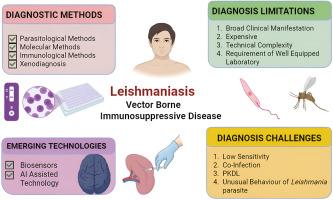利什曼病诊断的新趋势和创新战略:从古典时代到现代时代的巨大飞跃。
IF 2.5
3区 医学
Q2 PARASITOLOGY
引用次数: 0
摘要
利什曼原虫属包括一组表现出明显临床特征的独特物种。有趣的是,这种临床变异性经常重叠或交叉,导致症状不遵循典型模式,往往类似于那些不相关的疾病。诊断利什曼病具有挑战性,因为目前的技术表现出几个缺陷,包括与其他原生动物物种的交叉反应性,无法区分物种,以及不同的敏感性和特异性。因此,尽管临床上有多种方法可以确诊利什曼病,但仍存在缺陷,诊断方法还远远不够理想。在过去二十年中,非侵入性免疫学和分子技术的出现在改变和推进用于利什曼病的诊断方法方面发挥了关键作用。虽然诸如rK39 ELISA、直接凝集试验、间接荧光抗体试验和免疫层析试纸等抗体检测诊断非常敏感,但它们不能用于检测既往感染或区分利什曼原虫种类。分子方法,如PCR和LAMP测定已获得普及,因为他们非凡的敏感性和特异性,以及他们的多功能性,在分析不同的样品。然而,诊断与利什曼病相关的复发和合并感染仍然构成重大挑战。误诊和延误诊断都会严重影响患者的生存。这篇系统和全面的综述概述了利什曼原虫的传统和新兴诊断方法,包括生物传感器和基于人工智能的工具。它强调将传统方法与先进方法结合起来的创新战略,强调改进诊断对于有效发现、管理和控制疾病至关重要。本文章由计算机程序翻译,如有差异,请以英文原文为准。

Emerging trends and Innovative strategies for the diagnosis of Leishmaniasis: A quantum leap from classical to modern era
The genus Leishmania comprises a distinct group of species that exhibit distinct clinical features. Interestingly, this clinical variability frequently overlaps or intersects resulting in symptoms that don’t follow typical patterns and often resemble those of unrelated diseases. Diagnosing leishmaniasis is challenging as current techniques exhibit several lacunae including cross-reactivity with other protozoal species, inability to discriminate between species, along with differential sensitivity and specificity. Thus, despite multiple methods that can clinically confirm leishmaniasis disease, there are pitfalls present and the diagnostic methods are still far from being ideal. Over the last two decades, the emergence of non-invasive immunological and molecular techniques have played a key role in transforming and advancing the diagnostic approaches used for leishmaniasis. Although antibody-detection diagnostics such as rK39 ELISA, direct agglutination tests, indirect fluorescent antibody tests and immunochromatographic strip tests are very sensitive, they cannot be used to detect prior infections or to distinguish between Leishmania species. Molecular methods such as PCR and LAMP assay have gained popularity because of their extraordinary sensitivity and specificity as well as their versatility in analysing varied samples. However, diagnosing relapses and co-infections associated with leishmaniasis continues to pose significant challenges. Both misdiagnosis and delayed diagnosis can significantly impact a patient’s survival. Here, this systematic and comprehensive review provides an overview of both conventional and emerging diagnostic methods for Leishmania, including biosensors and AI-based tools. It highlights innovative strategies to bridge traditional and advanced methods, emphasizing that improved diagnostics are critical for effective disease detection, management and control.
求助全文
通过发布文献求助,成功后即可免费获取论文全文。
去求助
来源期刊

Acta tropica
医学-寄生虫学
CiteScore
5.40
自引率
11.10%
发文量
383
审稿时长
37 days
期刊介绍:
Acta Tropica, is an international journal on infectious diseases that covers public health sciences and biomedical research with particular emphasis on topics relevant to human and animal health in the tropics and the subtropics.
 求助内容:
求助内容: 应助结果提醒方式:
应助结果提醒方式:


